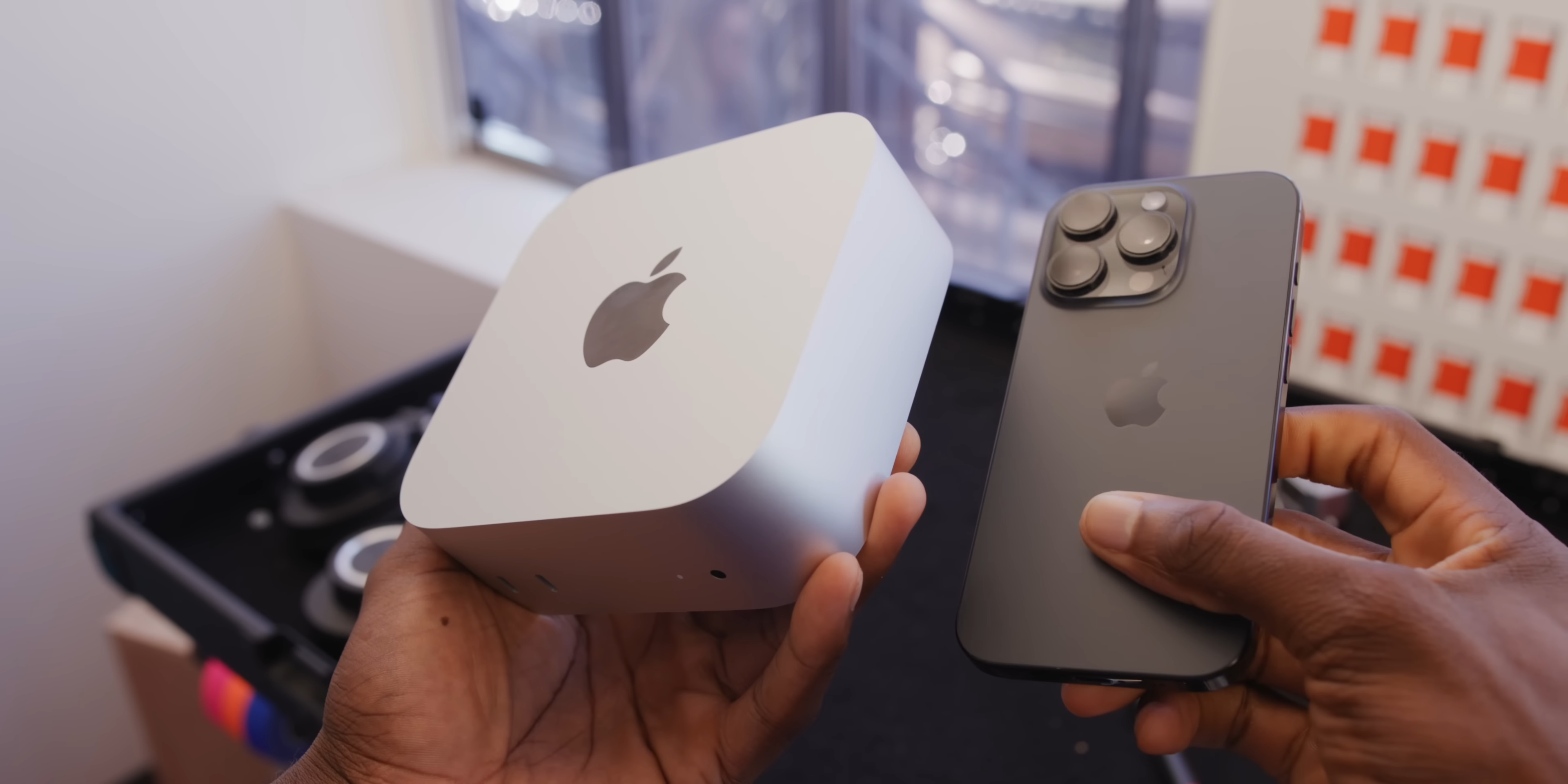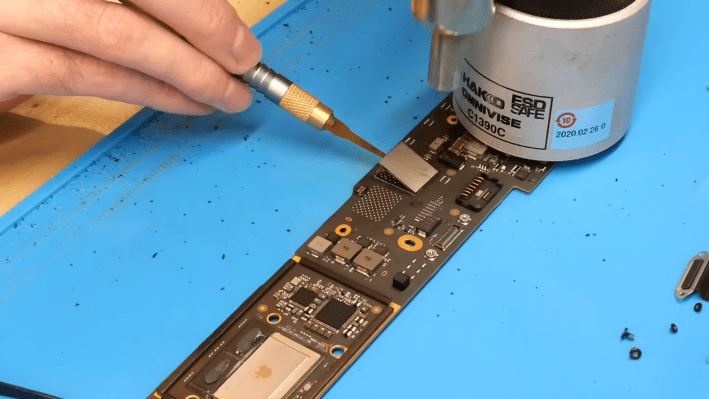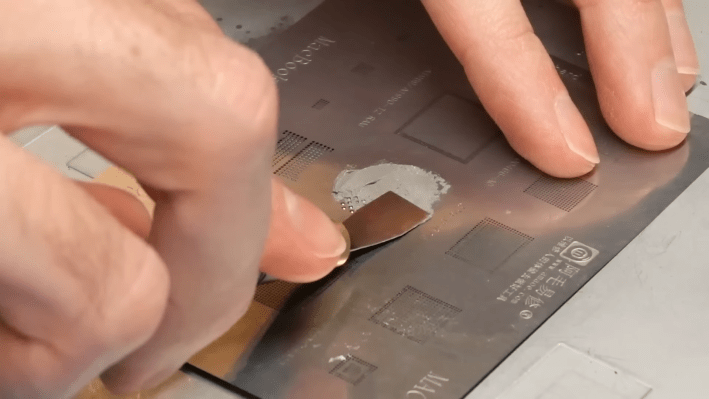One of the smartest moves Apple ever pulled, up there with the iPhone itself, was investing in Apple silicon. Starting with 2020’s M1 onward, Apple’s SoC’s (System on Chip) have been the best designed out there. The MacBook Air absolutely screams and has a battery that doesn’t quit. The latest M4 Mac mini redesign is a staggering performance jump and thus a fantastic deal.

Or rather, it would be, if not for one perennial issue – the storage in the majority of Apple’s products is not user upgradable and (mostly) soldered directly on the board, although the M4 Mac mini differs slightly. You’re stuck with whatever internal hard drive space you start off with. The pricing is also borderline criminal. But that has not and will not stop people from upgrading the SSDs on MacBook Airs and Mac minis by painfully desoldering the NAND chips and installing new ones themselves, as YouTuber DosDude1 has shown.
It’s iPhones All The Way Down
Apple, as a general rule, has rarely been open with its hardware or software. On some level, doing things this way makes sense. When your biggest success is unquestionably the iPhone, you eventually just have to design everything that way.
“Historically, ALL Apple SoCs since the original iPhone (which is from a time before Apple even designed their own SoCs) have been designed in this way,” Collin Mistr, who goes by dosdude1, told me when I asked about how Apple designs their products, “where the RAM is soldered to the package via a ‘POP’ (package-on-package) design, and using their own implementation for storage with a raw connection from the SoC to the NAND.”
In Apple’s computers, the flash memory controller is integrated into the SoC, as opposed to a standard NVMe drive you’d buy from a MicroCenter where the controller is on the drive itself. “Such a design choice (soldered storage) is considered normal for mobile devices, though not as much so for computers,” Collin told me. “So to me it is simply implemented this way because, well, that’s literally just how it’s always been done with this system design.”
If you have ever soldered or desoldered anything, watching Collin’s upgrade videos can be nerve wracking, deeply comforting or somehow both. Like some of the best YouTubers, he exists mainly as a soothing voice and a pair of hands. Though he works on all sorts of devices such as older Mac hardware, the Steam Deck and the Lenovo Go, his videos blew up a year ago with one where he upgraded the storage on an M1 Mac mini.

Collin’s upgrade videos have a surgical quality to them. He first removes the existing NAND from the board using a hot air gun to loosen the solder. Any underfill there is potentially scraped away using a specialty tool. After heating and gentle prying, the chip pops up. He then goes through the process of manually removing and cleaning the board. Fresh solder is reapplied to the PCB using flux, a common chemical that improves the flow of solder. In the case of his M1 MacBook Air video specifically, only one of potentially two NANDs is populated while the other is barren. To upgrade this he applies fresh solder to the pads, takes tiny 0201 resistors from a donor PCB and individually populates them over on the other board. I have done this with much larger resistors fairly recently and can tell you that it is a huge pain in the ass that sucks to do.

From there, Collin moves on to the “reballing” of the fresh, high capacity, totally blank NAND flash. Each NAND is connected via a series of tiny soldered connections in a grid pattern. Solder paste (as opposed to solder wire) is applied to the back of the chip using a stencil attached with kapton tape, and then hot air and slight pressure are applied to melt the balls evenly. Another round of flux and hot air is applied to the NAND modules to make sure the balls are uniform. From there, more flux is applied to the PCB, the freshly balled chips are aligned to that grid as accurately as possible, and hot air is applied to melt the solder exactly where it should be. The freshly upgraded Mac is then put into DFU mode and connected to a host PC which will (hopefully) reinstall MacOS. See? Easy.
Collin says he got his start the way many tinkerers do: getting inexpensive hardware with faulty boards from eBay to learn various diagnostic techniques and build up his toolset. By tinkering, he got good at reverse engineering Mac repair hacks and modifications.
“I think the earliest mod I attempted was upgrading PowerPC Mac CPUs, doing things like upgrading PowerPC G3-based systems to G4 CPUs,” he says. In addition to his popular Mac upgrade videos, he’s also upgraded the soldered RAM modules of the Steam Deck and the Lenovo Legion Go.
One of the best Macs ever
This brings us back to the M4 Mac mini. It quickly caught the attention of journalists and YouTubers alike for two ultimately meaningless and novel choices: shrinking down the device to be in line with every other mini PC that comes out of China and putting the power button on the bottom in a way that is both annoying and very much Apple. But the really important thing is that it’s a fantastic computer. Ars Technica called it “Apple’s best Mac mini’s ever.” This is to say nothing of the M4 Pro and M4 Max, which are wiping the floor with the competition in benchmarks. It is one of the most power-efficient computers ever made, and at idle it consumes 3-4 watts of power, roughly about the same as a Raspberry Pi, according to homelab expert Jeff Geerling. The Mac mini has gone from being the unassuming workhorse in Apple’s lineup to possibly one of the best computers it makes.
The base model M4 Mac mini comes with 16 GB of RAM for $599, but the base model SSD remains borderline unusable 256 GB. That is not a functional amount of storage in 2024. Want to upgrade to 512 GB or 1 TB? Unless you plan on living off of external drives, those are $200 and $400 dollar price hikes respectively. In an age where you can pick up a 1 TB M.2 drive for $60 ($100 if you want it to go real fast) those prices are borderline criminal.
The M4 Mac mini differs from the previous Mac mini in that the NAND flash is physically removable without desoldering. Like the Mac Studio before it, the NAND flash is stored on a proprietary module that is removable. This does not, however, mean you can just throw any SSD in. In order to upgrade the chip you still need to go through the same painful steps as before.
“The only difference is Apple physically moved the NANDs onto a removable module instead of soldering them directly to the board,” Collin told me. When performing upgrades “it must be treated as though it is soldered storage.”
Despite this, the new Mac mini design has much more potential for upgradability. In his previous video about the similar Mac Studio, Collin used a custom, reverse engineered PCB made by his friend Giles at Polysoft Services (that module is still in the Kickstarter phase as of me writing this) “It is now feasible to sell those with NANDs installed to users, allowing them to perform their own upgrades.”
The Future Is User-Serviceable
One of the richest companies in the world probably isn’t soliciting feedback on how to run a business, although I am going to provide it anyway. With Apple Silicon, the MacBook Air and mini became so good that even I had to begrudgingly admit their utility, and the M4 Mac mini’s NAND being semi-removable is a step in the right direction. But this storage racket has to stop. What’s more, with various Right to Repair laws passing, Apple is finally caving a little bit on the issue of parts pairing for iPhones and iPads, although its implementation has been buggy at best. “[Parts pairing] is completely unnecessary, has no benefit, and serves only to prevent users from easily swapping parts,” Collin told me.
Regardless of what Apple offers in the future, willingly or via legislation, the door has already been opened. You can’t expect people not to tinker and repair their technology and to show others how to do it, like Collin has. The future is user-serviceable whether Apple likes it or not.


